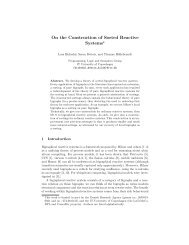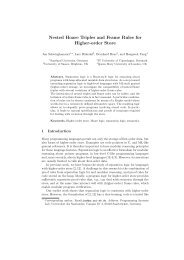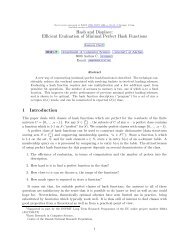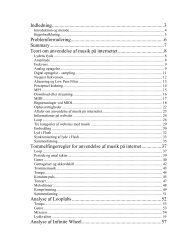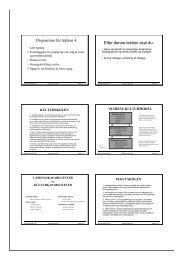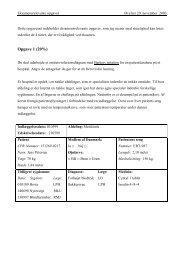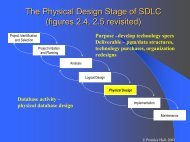Equivalence Checking of Combinational Circuits using ... - CiteSeerX
Equivalence Checking of Combinational Circuits using ... - CiteSeerX
Equivalence Checking of Combinational Circuits using ... - CiteSeerX
You also want an ePaper? Increase the reach of your titles
YUMPU automatically turns print PDFs into web optimized ePapers that Google loves.
PC <strong>using</strong> only 32 MB <strong>of</strong> memory. Even known difficult circuits<br />
(like s38417) are verified <strong>using</strong> modest resources (in less than<br />
an hour with 64 MB <strong>of</strong> memory). This demonstrates that BEDs<br />
combined with very simple algorithms are effective for solving<br />
the combinational logic-level equivalence problem.<br />
BEDs can be seen as an intermediate form between the compact<br />
circuits and the canonical OBDDs, and thus combines the<br />
functional and the structural verification techniques. All standard<br />
OBDD operations can be performed on BEDs as well.<br />
Some operations, like existential quantification and substitution,<br />
can be performed directly on the data structure by <strong>using</strong><br />
UP_ONE [4], making the runtime <strong>of</strong> these operations linear in<br />
the size <strong>of</strong> the BED. Other operations, like satisfiability and<br />
tautology, can be performed by transforming the BED into an<br />
equivalent OBDD.<br />
Due to the simplicity and generality <strong>of</strong> BEDs, it is to be expected<br />
that combining them with other approaches to equivalence<br />
checking will be both straightforward and beneficial. The<br />
benefits could be in two directions. Firstly, BEDs could be used<br />
either as a “filter” in the filter-based approaches [45] or as the<br />
basic data structure for representing circuits in any <strong>of</strong> the other<br />
approaches allowing, for instance, a gradual and smooth transition<br />
from circuits to BDDs. Secondly, BEDs could benefit from<br />
other equivalence checkers. Whenever two subcircuits by some<br />
means can be determined equivalent, the corresponding nodes<br />
<strong>of</strong> the BED could be merged into one, resulting in an immediate<br />
reduction in size. Moreover, this immediate reduction could<br />
result in further reductions being possible by the reduction rules<br />
and improve on the efficiency on later BDD-conversions.<br />
BEDs are particularly useful in applications where the endresult<br />
as an OBDD is small, for example, for tautology checking.<br />
Another area that may benefit from <strong>using</strong> the BED representation<br />
is symbolic model checking. Several researchers<br />
have observed that when performing fixed-point iterations <strong>using</strong><br />
OBDDs, the intermediate results are <strong>of</strong>ten much larger than<br />
the final result. Clearly, the succinctness <strong>of</strong> BEDs compared to<br />
OBDDs can alleviate this problem. In fact, many <strong>of</strong> the tricks<br />
researchers have used to make OBDDs more efficient are embodied<br />
in BEDs. For example, Burch, Clarke, and Long [46]<br />
demonstrated that the complexity <strong>of</strong> BDD-based symbolic verification<br />
is drastically reduced by <strong>using</strong> a partitioned transition<br />
relation where the transition relation is represented as an implicit<br />
conjunction <strong>of</strong> OBDDs. This corresponds to representing<br />
the transition relation as a BED with conjunction vertices at the<br />
top level and only lifting the variables up to just under these<br />
vertices.<br />
REFERENCES<br />
[1] M. Fujita, “Verification <strong>of</strong> arithmetic circuits by comparing two similar<br />
circuits,” in Computer Aided Verification (CAV). 1996, Lecture Notes in<br />
Computer Science, pp. 159–168, Springer-Verlag.<br />
[2] C.A.J. van Eijk, “Sequential equivalence checking without state space<br />
traversal,” in Proc. International Conf. on Design Automation and Test <strong>of</strong><br />
Electronic-based Systems (DATE), 1998.<br />
[3] R. E. Bryant, “Graph-based algorithms for Boolean function manipulation,”<br />
IEEE Transactions on Computers, vol. 35, no. 8, pp. 677–691, Aug.<br />
1986.<br />
[4] H. R. Andersen and H. Hulgaard, “Boolean Expression Diagrams,” in<br />
IEEE Symposium on Logic in Computer Science (LICS), July 1997.<br />
[5] R. B. Boppana and M. Sipser, “The complexity <strong>of</strong> finite functions,” in<br />
Handbook <strong>of</strong> Theoretical Computer Science, J. van Leeuwen, Ed., vol.<br />
A: Algorithms and Complexity, pp. 758–804. Elsevier Science Publisher,<br />
1990.<br />
[6] T. H. Cormen, C. E. Leiserson, and R. L. Rivest, Introduction to Algorithms,<br />
MIT Press, 1990.<br />
[7] E. Sentovich et al., “SIS: A system for sequential circuit synthesis,” Tech.<br />
Rep. Memorandum No. UCB/ERL M92/41, Electronics Research Laboratory,<br />
Dept. <strong>of</strong> EECS, University <strong>of</strong> California, Berkeley, 1992.<br />
[8] R. Drechsler, A. Sarabi, M. Theobald, B. Becker, and M.A. Perkowski,<br />
“Efficient representation and manipulation <strong>of</strong> switching functions based<br />
on ordered Kronecker functional decision diagrams,” in Proc. ACM/IEEE<br />
Design Automation Conference (DAC), 1994, pp. 415–419.<br />
[9] U. Kebschull, E. Schubert, and W. Rosenstiel, “Multilevel logic synthesis<br />
based on functional decision diagrams,” in Proc. European Conference on<br />
Design Automation (EDAC), 1992, pp. 43–47.<br />
[10] J. Gergov and C. Meinel, “Efficient Boolean manipulation with OBDD’s<br />
can be extended to FBDD’s,” IEEE Transactions on Computers, vol. 43,<br />
no. 10, pp. 1197–1209, Oct. 1994.<br />
[11] E. I. Goldberg, Y. Kukimoto, and R. K. Brayton, “Canonical TBDD’s<br />
and their application to combinational verification,” in Proc. International<br />
Workshop on Logic Synthesis, 1997.<br />
[12] J. Jain, J. Bitner, M. S. Abadir, and J. A. Abraham amd D. S. Fussell, “Indexed<br />
BDDs: Algorithmic advances in techniques to represent and verify<br />
Boolean functions,” IEEE Transactions on Computers, vol. 46, no. 11, pp.<br />
1230–1245, Nov. 1997.<br />
[13] D. Sieling and I. Wegener, “Graph driven BDDs – a new data structure for<br />
Boolean functions,” Theoretical Computer Science, vol. 141, no. 1-2, pp.<br />
283–310, 1995.<br />
[14] R. I. Bahar, E. A. Frohm, C. M. Gaona, G. D. Hachtel, E. Macii, A. Pardo,<br />
and F. Somenzi, “Algebraic decision diagrams and their applications,”<br />
in Proc. International Conf. Computer-Aided Design (ICCAD), 1993, pp.<br />
188–191.<br />
[15] R. E. Bryant and Y.-A. Chen, “Verification <strong>of</strong> arithmetic functions with<br />
binary moment diagrams,” in Proc. ACM/IEEE Design Automation Conference<br />
(DAC), 1995, pp. 535–541.<br />
[16] E. M. Clarke, K.L. McMillan, X. Zhao, M. Fujita, and J. Yang, “Spectral<br />
transforms for large Boolean functions with application to technology<br />
mapping,” in Proc. ACM/IEEE Design Automation Conference (DAC),<br />
1993, pp. 54–60.<br />
[17] A. Kuehlmann and F. Krohm, “<strong>Equivalence</strong> checking <strong>using</strong> cuts and<br />
heaps,” in Proc. ACM/IEEE Design Automation Conference (DAC), 1997,<br />
vol. 34, pp. 263–268.<br />
[18] D. Brand, “Verification <strong>of</strong> large synthesized designs,” in Proc. International<br />
Conf. Computer-Aided Design (ICCAD), 1993, pp. 534–537.<br />
[19] W. Kunz, “HANNIBAL: An efficient tool for logic verification based on<br />
recursive learning,” in Proc. International Conf. Computer-Aided Design<br />
(ICCAD), 1993, pp. 538–543.<br />
[20] W. Kunz and D. K. Pradhan, “Recursive learning: A new implication<br />
technique for efficient solutions to CAD problems – test, verification, and<br />
optimization,” IEEE Transactions on Computer Aided Design, vol. 13, no.<br />
9, pp. 1143–1158, Sept. 1994.<br />
[21] W. Kunz, D. K. Pradhan, and S. M. Reddy, “A novel framework for logic<br />
verification in a synthesis environment,” IEEE Transactions on Computer<br />
Aided Design, vol. 15, no. 1, pp. 20–32, Jan. 1996.<br />
[22] D. K. Pradhan, D. Paul, and M. Chatterjee, “VERILAT: Verification <strong>using</strong><br />
logic augmentation and transformations,” in Proc. International Conf.<br />
Computer-Aided Design (ICCAD), Nov. 1996.<br />
[23] J. Jain, R. Mukherjee, and M. Fujita, “Advanced verification techniques<br />
based on learning,” in Proc. ACM/IEEE Design Automation Conference<br />
(DAC), 1995, pp. 629–634.<br />
[24] Y. Matsunaga, “An efficient equivalence checker for combinational circuits,”<br />
in Proc. ACM/IEEE Design Automation Conference (DAC), 1996,<br />
pp. 629–634.<br />
[25] C.A.J. van Eijk and G. L. J. M. Janssen, “Exploiting structural similarities<br />
in a BDD-based verification method,” in Theorem Provers in Circuit<br />
Design. 1994, number 901 in Lecture Notes in Computer Science, pp.<br />
110–125, Springer-Verlag.<br />
[26] C.A.J. van Eijk, Formal Methods for the Verification <strong>of</strong> Digital <strong>Circuits</strong>,<br />
Ph.D. thesis, Technische Universitet Eindhoven, 1997.<br />
[27] E. Cerny and C. Mauras, “Tautology checking <strong>using</strong> cross-controllability<br />
and cross-observability relations,” in Proc. International Conf. Computer-<br />
Aided Design (ICCAD), 1990.<br />
[28] T. E. Uribe and M. E. Stickel, “Ordered binary decision diagrams and the<br />
Davis-Putnam procedure,” in 1st International Conference on Constraints<br />
in Computational Logics, J.P. Jouannaud, Ed., Sept. 1994, vol. 845 <strong>of</strong> Lecture<br />
Notes in Computer Science.<br />
[29] G.D. Hachtel and R.M. Jacoby, “Verification algorithms for VLSI synthesis,”<br />
IEEE Transactions on Computer Aided Design, pp. 616–640, May<br />
1988.





